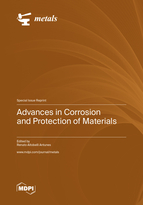Advances in Corrosion and Protection of Materials
A special issue of Metals (ISSN 2075-4701). This special issue belongs to the section "Corrosion and Protection".
Deadline for manuscript submissions: closed (31 January 2023) | Viewed by 27769
Special Issue Editor
Interests: corrosion mechanisms; localized corrosion; corrosion-fatigue; local probe techniques; surface chemistry; biomedical alloys; magnesium alloys
Special Issues, Collections and Topics in MDPI journals
Special Issue Information
Dear Colleagues,
Corrosion plays a central role in modern civilization, impacting the costs of a variety of industry sectors. As concerns related to the safety and performance of materials evolve, knowledge about corrosion mechanisms and protection methods becomes increasingly important to support growing technological developments. The design of new materials and manufacturing methods must rely on a careful analysis of the corrosion resistance, especially on the correlation between chemical composition, processing parameters, metallurgical aspects and surface characteristics. In this challenging scenario, corrosion research is crucial. Novel research fields have emerged in the past few years, bringing a huge amount of information on hot topics such as multiprinciple metallic alloys, additively manufactured alloys, friction stir welded materials, localized corrosion processes studied by scanning probe techniques, biomedical alloy, and new protective coatings.
The aim of this Special Issue is to provide the readership of Metals with the most up-to-date research in the corrosion and protection of materials. The interests are particularly related to corrosion of novel metallic alloys, corrosion mechanisms, correlation between surface chemistry and corrosion, novel manufacturing methods (additive manufacturing, friction stir welding), effects of metallurgical aspects on corrosion (heat treatments, crystalline phases, microstructure, grain size, texture), use of scanning probe techniques to study local corrosion processes, protective coatings, and surface treatments. We welcome reviews and research articles.
Prof. Dr. Renato Altobelli Antunes
Guest Editor
Manuscript Submission Information
Manuscripts should be submitted online at www.mdpi.com by registering and logging in to this website. Once you are registered, click here to go to the submission form. Manuscripts can be submitted until the deadline. All submissions that pass pre-check are peer-reviewed. Accepted papers will be published continuously in the journal (as soon as accepted) and will be listed together on the special issue website. Research articles, review articles as well as short communications are invited. For planned papers, a title and short abstract (about 100 words) can be sent to the Editorial Office for announcement on this website.
Submitted manuscripts should not have been published previously, nor be under consideration for publication elsewhere (except conference proceedings papers). All manuscripts are thoroughly refereed through a single-blind peer-review process. A guide for authors and other relevant information for submission of manuscripts is available on the Instructions for Authors page. Metals is an international peer-reviewed open access monthly journal published by MDPI.
Please visit the Instructions for Authors page before submitting a manuscript. The Article Processing Charge (APC) for publication in this open access journal is 2600 CHF (Swiss Francs). Submitted papers should be well formatted and use good English. Authors may use MDPI's English editing service prior to publication or during author revisions.
Keywords
- Multiprinciple alloys
- Biomedical alloys
- Scanning probe techniques
- Protective coatings
- Corrosion mechanisms
- Surface chemistry
- Additive manufacturing






